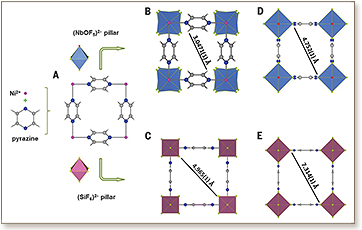

 The chemical industry is dependent on the olefin/paraffin separation, which is mainly accomplished by using energy-intensive processes. We report the use of reticular chemistry for the fabrication of a chemically stable fluorinated metal-organic framework (MOF) material (NbOFFIVE-1-Ni, also referred to as KAUST-7). The bridging of Ni(II)-pyrazine square-grid layers with (NbOF5)2– pillars afforded the construction of a three-dimensional MOF, enclosing a periodic array of fluoride anions in contracted square-shaped channels. The judiciously selected bulkier (NbOF5)2– caused the looked-for hindrance of the previously free-rotating pyrazine moieties, delimiting the pore system and dictating the pore aperture size and its maximum opening. The restricted MOF window resulted in the selective molecular exclusion of propane from propylene at atmospheric pressure, as evidenced through multiple cyclic mixed-gas adsorption and calorimetric studies.
The chemical industry is dependent on the olefin/paraffin separation, which is mainly accomplished by using energy-intensive processes. We report the use of reticular chemistry for the fabrication of a chemically stable fluorinated metal-organic framework (MOF) material (NbOFFIVE-1-Ni, also referred to as KAUST-7). The bridging of Ni(II)-pyrazine square-grid layers with (NbOF5)2– pillars afforded the construction of a three-dimensional MOF, enclosing a periodic array of fluoride anions in contracted square-shaped channels. The judiciously selected bulkier (NbOF5)2– caused the looked-for hindrance of the previously free-rotating pyrazine moieties, delimiting the pore system and dictating the pore aperture size and its maximum opening. The restricted MOF window resulted in the selective molecular exclusion of propane from propylene at atmospheric pressure, as evidenced through multiple cyclic mixed-gas adsorption and calorimetric studies.